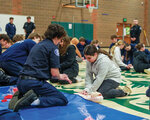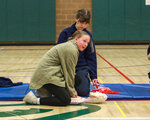



Cadets with Clark County Fire District 3 (CCFD3) recently taught Tukes Valley Middle School students CPR to the tune of ‘Stayin Alive.’
On Monday, March 18, fifth through eighth graders learned how to provide hands-only CPR as part of the Kids Heart Challenge curriculum in physical education class.
The CPR training wasn’t short of a good tune and a lot of smiles from everyone involved.
Despite listening to multiple songs with 100 beats per minute, aimed at teaching the youth to keep a steady compression rate for effective chest compressions. The most popular was the aptly titled “Stayin Alive” by the Bee Gees.
At Tukes Valley and Chief Umtuch Middle Schools, students learned lifesaving skills in a hands-on way as opposed to quizzes and learning online, said Mollie Shannon with the American Heart Association.
“Seventy percent of cardiac events happen outside the hospital, and so if you end up having to do CPR on someone, it’s going to probably be on someone that you know and love — a friend or a family member,” Shannon said. “So it’s really awesome to give all of these kids the opportunity to know what to do in an emergency and just have the ability to feel confident that they know how to help. We want someone in every room that knows CPR.”
The American Heart Association’s Kids Heart Challenge lasts up to four weeks at schools starting with an assembly to introduce students to the importance of caring for their hearts.
“Throughout the next few weeks [the students] usually practice drinking water, getting extra exercise, being kind, keeping their hearts happy and healthy and getting sleep, those kinds of things,” Shannon said of the curriculum. “They also have the option to fundraise for the American Heart Association and help people who have special hearts.”
CCFD3 training Capt. Dustin Waliezer said CPR is something anyone can do and learn in just two minutes or less.
“Really, it’s setting the stage for that first four minutes where the body is not able to move blood to the brain. That part of the body will actually start dying,” Waliezer said. “So, CPR helps bridge that gap … if someone goes into cardiac arrest to the time that we can get there as first responders to assume that process.”
Waliezer students enjoyed the other activities with fire cadets, which included volleyball and activities to promote staying active and healthy.
To learn more about the American Heart Association, visit heart.org/.